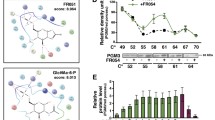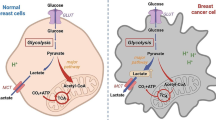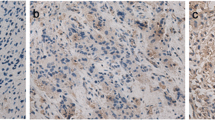Abstract
The azido sugar, GalNAz, was successfully used for imaging and perturbing protein glycosylation in triple-negative breast cancer cell line, MDA-MB-231. After the incorporation of GalNAz in the triple-negative breast cancer cell line, the tumorigenicity of these cells was decreased. Results from gene analysis and drug treatment suggest that the tumorigenicity decrease may be attributed to the reduction of cancer stem cell population. Possible mechanisms of GalNAz induced cancer stem cells (CSCs) proportion change are discussed.
Similar content being viewed by others
References
Rakha EA, Elsheikh SE, Aleskandarany MA, Habashi HO, Green AR, Powe DG, El-Sayed ME, Benhasouna A, Brunet JS, Akslen LA, Evans AJ, Blamey R, Reis-Filho JS, Foulkes WD, Ellis IO. Triple- negative breast cancer: Distinguishing between basal and nonbasal subtypes. Clinic Cancer Res, 2009, 15: 2302–2310
Sun B, Zhang S, Zhang D, Li Y, Zhao X, Luo Y, Guo Y. Identification of metastasis-related proteins and their clinical relevance to triple-negative human breast cancer. Clinic Cancer Res, 2008, 14: 7050–7059
Charafe-Jauffret E, Ginestier C, Iovino F, Wicinski J, Cervera N, Finetti P, Hur MH, Diebel ME, Monville F, Dutcher J, Brown M, Viens P, Xerri L, Bertucci F, Stassi G, Dontu G, Birnbaum D, Wicha MS. Breast cancer cell lines contain functional cancer stem cells with metastatic capacity and a distinct molecular signature. Cancer Res, 2009, 69: 1302–1313
Hart GW, Copeland RJ. Glycomics hits the big time. Cell, 2010, 143: 672–676
Heal WP, Tate EW. Getting a chemical handle on protein post- translational modification. Org Biomol Chem, 2010, 8: 731–738
Agard NJ, Bertozzi CR. Chemical approaches to perturb, profile, and perceive glycans. Acc Chem Res, 2009, 42: 788–797
Carraway KL, Hull SR. Cell surface mucin-type glycoproteins and mucin-like domains. Glycobiology, 1991, 1: 131–138
Springer GF. T and Tn, general carcinoma autoantigens. Science, 1984, 224: 1198–1206
Gill DJ, Clausen H, Bard F. Location, location, location: New insights into O-GalNAc protein glycosylation. Trends Cell Biol, 2011, 21: 149–158
Handerson T, Pawelek JM. β1,6-branched oligosaccharides and coarse vesicles. Cancer Res, 2003, 63: 5363–5369
Handerson T, Camp R, Harigopal M, Rimm D, Pawelek J. β1,6- branched oligosaccharides are increased in lymph node metastases and predict poor outcome in breast carcinoma. Clinic Cancer Res, 2005, 11: 2969–2973
Dennis JW, Laferte S, Waghorne C, Breitman ML, Kerbel RS. Beta 1–6 branching of Asn-linked oligosaccharides is directly associated with metastasis. Science, 1987, 236: 582–585
Slawson C, Hart GW. O-GlcNAc signalling: implications for cancer cell biology. Nat Rev Cancer, 2011, 11: 678–684
Dorfmueller HC, Borodkin VS, Schimpl M, Shepherd SM, Shpiro NA, van Aalten DMF. GlcNAcstatin: A picomolar, selective O-GlcNAcase inhibitor that modulates intracellular O-GlcNAcylation levels. J Am Chem Soc, 2006, 128: 16484–16485
Kim EJ, Perreira M, Thomas CJ, Hanover JA. An O-GlcNAcase- specific inhibitor and substrate engineered by the extension of the N-acetyl moiety. J Am Chem Soc, 2006, 128: 4234–4235
Konrad RJ, Zhang F, Hale JE, Knierman MD, Becker GW, Kudlow JE. Alloxan is an inhibitor of the enzyme O-linked N-acetylglucosamine transferase. Biochem Biophys Res Comm, 2002, 293: 207–212
Li T, Guo L, Zhang Y, Wang J, Li Z, Lin L, Zhang Z, Li L, Lin J, Zhao W, Li J, Wang PG. Design and synthesis of O-GlcNAcase inhibitors via’ click chemistry’ and biological evaluations. Carbohydrate Res, 2011, 346: 1083–1092
Li J, Li Z, Li T, Lin L, Zhang Y, Guo L, Xu Y, Zhao W, Wang P. Identification of a specific inhibitor of nOGA—A caspase-3 cleaved O-GlcNAcase variant during apoptosis. Biochemistry (Moscow), 2012, 77: 194–200
Liu K, Paterson AJ, Konrad RJ, Parlow AF, Jimi S, Roh M, Chin Jr E, Kudlow JE. Streptozotocin, an O-GlcNAcase inhibitor, blunts insulin and growth hormone secretion. Mol Cell Endocrinol, 2002, 194: 135–146
Macauley MS, He Y, Gloster TM, Stubbs KA, Davies GJ, Vocadlo DJ. Inhibition of O-GlcNAcase using a potent and cell-permeable inhibitor does not induce insulin resistance in 3T3-L1 adipocytes. Chem Biol, 2010, 17: 937–948
Yuzwa SA, Macauley MS, Heinonen JE, Shan X, Dennis RJ, He Y, Whitworth GE, Stubbs KA, McEachern EJ, Davies GJ, Vocadlo DJ. A potent mechanism-inspired O-GlcNAcase inhibitor that blocks phosphorylation of tau in vivo. Nat Chem Biol, 2008, 4: 483–490
Nishimura SI, Hato M, Hyugaji S, Feng F, Amano M. Glycomics for drug discovery: Metabolic perturbation in androgen-independent prostate cancer cells induced by unnatural hexosamine mimics. Angew Chem Int Ed, 2012, 51: 3386–3390
Winans KA, Bertozzi CR. An inhibitor of the human UDP-GlcNAc 4-epimerase identified from a uridine-based library: A strategy to inhibit O-linked glycosylation. Chem Biol, 2002, 9: 113–129
Bertozzi CR, Kiessling LL. Chemical glycobiology. Science, 2001, 291: 2357–2364
Qi Y, Fu X, Xiong Z, Zhang H, Hill SM, Rowan BG, Dong Y. Methylseleninic acid enhances paclitaxel efficacy for the treatment of triple-negative breast cancer. PLoS ONE, 2012, 7: e31539
Yang L, Wu X, Wang Y, Zhang K, Wu J, Yuan YC, Deng X, Chen L, Kim CCH, Lau S, Somlo G, Yen Y. FZD7 has a critical role in cell proliferation in triple negative breast cancer. Oncogene, 2011, 30: 4437–4446
Yuan K, Listinsky C, Singh R, Listinsky J, Siegal G. Cell surface associated alpha-l-fucose moieties modulate human breast cancer neoplastic progression. Pathol Oncol Res, 2008, 14: 145–156
Dube DH, Prescher JA, Quang CN, Bertozzi CR. Probing mucin-type O-linked glycosylation in living animals. Proc Natl Acad Sci U S A, 2006, 103: 4819–4824
Hang HC, Yu C, Kato DL, Bertozzi CR. A metabolic labeling approach toward proteomic analysis of mucin-type O-linked glycosylation. Proc Natl Acad Sci USA, 2003, 100: 14846–14851
Laughlin ST, Baskin JM, Amacher SL, Bertozzi CR. In vivo imaging of membrane-associated glycans in developing zebrafish. Science, 2008, 320: 664–667
Clark PM, Dweck JF, Mason DE, Hart CR, Buck SB, Peters EC, Agnew BJ, Hsieh-Wilson LC. Direct in-gel fluorescence detection and cellular imaging of O-GlcNAC-modified proteins. J Am Chem Soc, 2008, 130: 11576–11577
Debets MF, van Berkel SS, Dommerholt J, Dirks AJ, Rutjes FPJT, van Delft FL Bioconjugation with strained alkenes and alkynes. Acc Chem Res, 2011, 44: 805–815
Ning XH, Guo J, Wolfert MA, Boons GJ. Visualizing metabolically labeled glycoconjugates of living cells by copper-free and fast huisgen cycloadditions. Angew Chem Int Edit, 2008, 47: 2253–2255
Cai L, Guan W, Wang W, Zhao W, Kitaoka M, Shen J, O’Neil C, Wang PG. Substrate specificity of N-acetylhexosamine kinase towards N-acetylgalactosamine derivatives. Bioorg Med Chem Lett, 2009, 19: 5433–5435
Hang HC, Yu C, Pratt MR, Bertozzi CR. Probing glycosyltransferase activities with the staudinger. J Am Chem Soc, 2003, 126: 6–7
Mani SA, Guo W, Liao MJ, Eaton EN, Ayyanan A, Zhou AY, Brooks M, Reinhard F, Zhang CC, Shipitsin M, Campbell LL, Polyak K, Brisken C, Yang J, Weinberg RA. The epithelial-mesenchymal transition generates cells with properties of stem cells. Cell, 2008, 133: 704–715
Livak KJ, Schmittgen TD. Analysis of relative gene expression data using real-time quantitative PCR and the 2-ΔΔCT method. Methods, 2001, 25: 402–408
Boyce M, Carrico IS, Ganguli AS, Yu SH, Hangauer MJ, Hubbard SC, Kohler JJ, Bertozzi CR. Metabolic cross-talk allows labeling of O-linked beta-N-acetylglucosamine-modified proteins via the N-acetylgalactosamine salvage pathway. Proc Natl Acad Sci USA, 2011, 108: 3141–3146
Zaro BW, Yang YY, Hang HC, Pratt MR. Chemical reporters for fluorescent detection and identification of O-GlcNAC-modified proteins reveal glycosylation of the ubiquitin ligase NEDD4-1. Proc Natl Acad Sci USA, 2011, 108: 8146–8151
Wang Q, Chan TR, Hilgraf R, Fokin VV, Sharpless KB, Finn MG. Bioconjugation by copper(I)-catalyzed azide-alkyne [3+2] cycloaddition. J Am Chem Soc, 2003, 125: 3192–3193
Baskin JM, Prescher JA, Laughlin ST, Agard NJ, Chang PV, Miller IA, Lo A, Codelli JA, Bertozzit CR. Copper-free click chemistry for dynamic in vivo imaging. Proc Natl Acad Sci USA, 2007, 104: 16793–16797
Friscourt F, Ledin PA, Mbua NE, Flanagan-Steet HR, Wolfert MA, Steet R, Boons GJ. Polar dibenzocyclooctynes for selective labeling of extracellular glycoconjugates of living cells. J Am Chem Soc, 2012, 134: 5381–5389
Dontu G, Abdallah WM, Foley JM, Jackson KW, Clarke MF, Kawamura MJ, Wicha MS. In vitro propagation and transcriptional profiling of human mammary stem/progenitor cells. Genes Dev, 2003, 17: 1253–1270
Grimshaw M, Cooper L, Papazisis K, Coleman J, Bohnenkamp H, Chiapero-Stanke L, Taylor-Papadimitriou J, Burchell J. Mammosphere culture of metastatic breast cancer cells enriches for tumorigenic breast cancer cells. Breast Cancer Res, 2008, 10: R52
Colburn NH, Bruegge WFV, Bates JR, Gray RH, Rossen JD, Kelsey WH, Shimada T. Correlation of anchorage-independent growth with tumorigenicity of chemically transformed mouse epidermal cells. Cancer Res, 1978, 38: 624–634
Shin SI, Freedman VH, Risser R, Pollack R. Tumorigenicity of virus-transformed cells in nude mice is correlated specifically with anchorage independent. Proc Natl Acad Sci USA, 1975, 72: 4435–4439
Prud’homme GJ, Glinka Y, Toulina A, Ace O, Subramaniam V, Jothy S. Breast cancer stem-like cells are inhibited by a non-toxic aryl hydrocarbon receptor agonist. PLoS ONE, 2010, 5: e13831
Reya T, Morrison SJ, Clarke MF, Weissman IL. Stem cells, cancer, and cancer stem cells. Nature, 2001, 414: 105–111
Al-Hajj M, Wicha MS, Benito-Hernandez A, Morrison SJ, Clarke MF. Prospective identification of tumorigenic breast cancer cells. Proc Natl Acad Sci USA, 2003, 100: 3983–3988
Delude C. Tumorigenesis: Testing ground for cancer stem cells. Nature, 2011, 480: S43–45
Croker AK, Goodale D, Chu J, Postenka C, Hedley BD, Hess DA, Allan AL. High aldehyde dehydrogenase and expression of cancer stem cell markers selects for breast cancer cells with enhanced malignant and metastatic ability. J Cell Mol Med, 2009, 13: 2236–2252
Storms RW, Trujillo AP, Springer JB, Shah L, Colvin OM, Ludeman SM, Smith C. Isolation of primitive human hematopoietic progenitors on the basis of aldehyde dehydrogenase activity. Proc Natl Acad Sci USA, 1999, 96: 9118–9123
Freire-de-Lima L, Gelfenbeyn K, Ding Y, Mandel U, Clausen H, Handa K, Hakomori SI. Involvement of O-glycosylation defining oncofetal fibronectin in epithelial-mesenchymal transition process. Proc Natl Acad Sci USA, 2011, 108: 17690–17695
Zeng Q, Li W, Lu D, Wu Z, Duan H, Luo Y, Feng J, Yang D, Fu L, Yan X. CD146, an epithelial-mesenchymal transition inducer, is associated with triple-negative breast cancer. Proc Natl Acad Sci USA, 2012, 109: 1127–1132
Hubbard SC, Boyce M, McVaugh CT, Peehl DM, Bertozzi CR. Cell surface glycoproteomic analysis of prostate cancer-derived PC-3 cells. Bioorg Med Chem Lett, 2011, 21: 4945–4950
Kobayashi CI, Suda T. Regulation of reactive oxygen species in stem cells and cancer stem cells. J Cell Physiol, 2012, 227: 421–430
Iliopoulos D, Hirsch HA, Wang G, Struhl K. Inducible formation of breast cancer stem cells and their dynamic equilibrium with non-stem cancer cells via IL6 secretion. Proc Natl Acad Sci USA, 2011, 108: 1397–1402
Author information
Authors and Affiliations
Corresponding authors
Rights and permissions
About this article
Cite this article
Duan, X., Cai, L., Lee, L.A. et al. Incorporation of azide sugar analogue decreases tumorigenic potential of breast cancer cells by reducing cancer stem cell population. Sci. China Chem. 56, 279–285 (2013). https://doi.org/10.1007/s11426-012-4806-4
Received:
Accepted:
Published:
Issue Date:
DOI: https://doi.org/10.1007/s11426-012-4806-4




